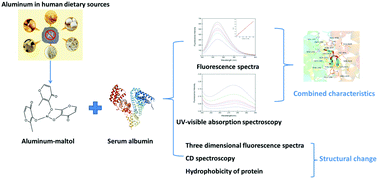Characterization of the binding mechanism and conformational changes of bovine serum albumin upon interaction with aluminum-maltol: a spectroscopic and molecular docking study†
Abstract
The widespread use of aluminum in the treatment of drinking water, food, agriculture and pharmaceuticals has greatly increased the risk of human exposure to excess aluminum, which is a serious health hazard to human beings. In our previous work, serum albumin was reported to have a specific affinity for aluminum. However, the mechanism of binding of aluminum to serum albumin was unclear. In this work, the interaction between bovine serum albumin (BSA) and aluminum-maltol (Al-Mal) was studied by molecular docking and spectroscopic analysis. The results show that the combination of Al-Mal and BSA is a spontaneous endothermic reaction. The binding force is mainly related to the hydrophobic force and hydrogen bonding; when the ratio of BSA to Al-Mal was 1 : 10, the random coils of BSA increased by 47.6%. In addition, the hydrophobicity of BSA was enhanced after combining with Al-Mal. This study can provide a theoretical evidence for the binding mechanism of food-borne aluminum and serum albumin.



 Please wait while we load your content...
Please wait while we load your content...